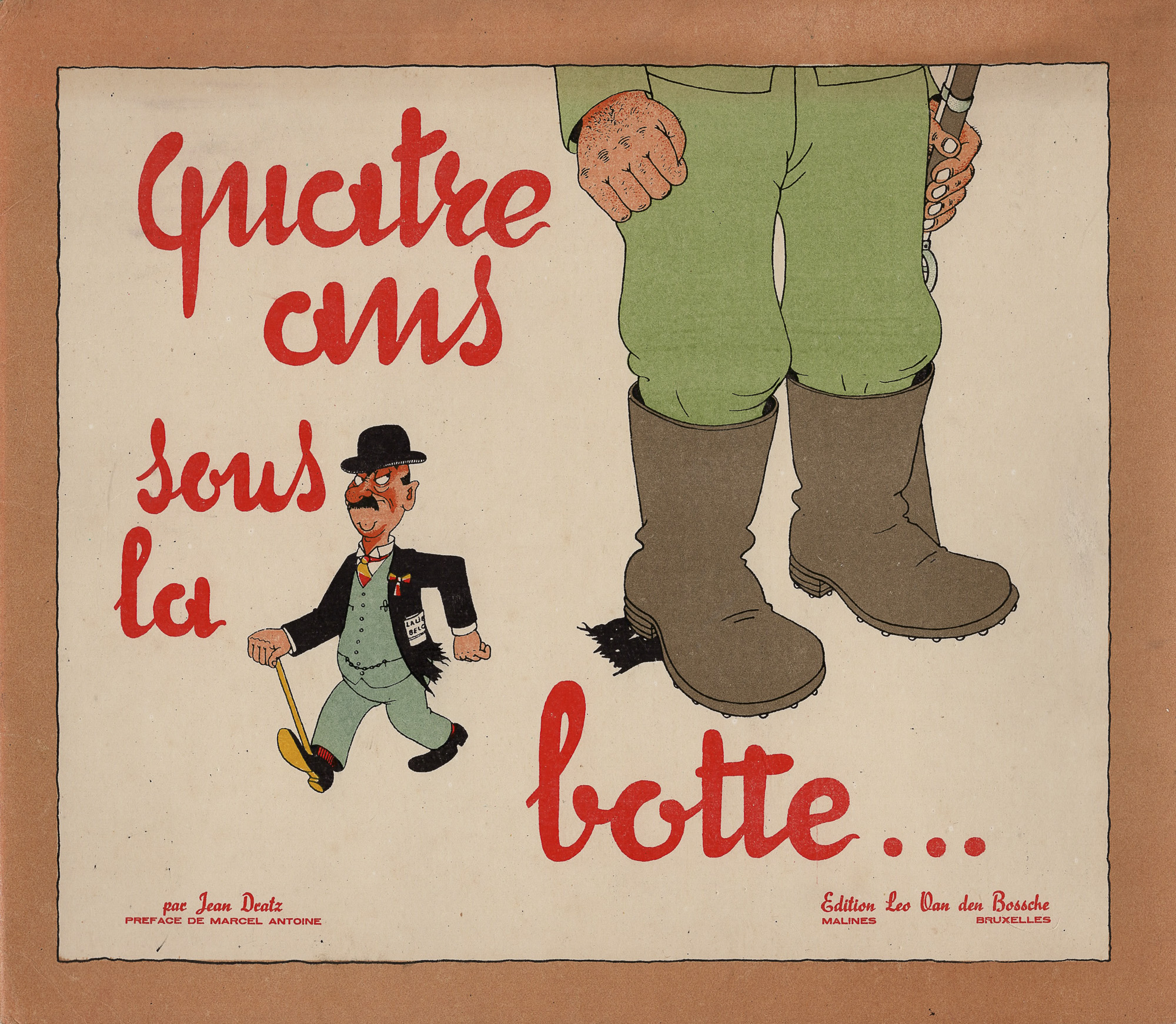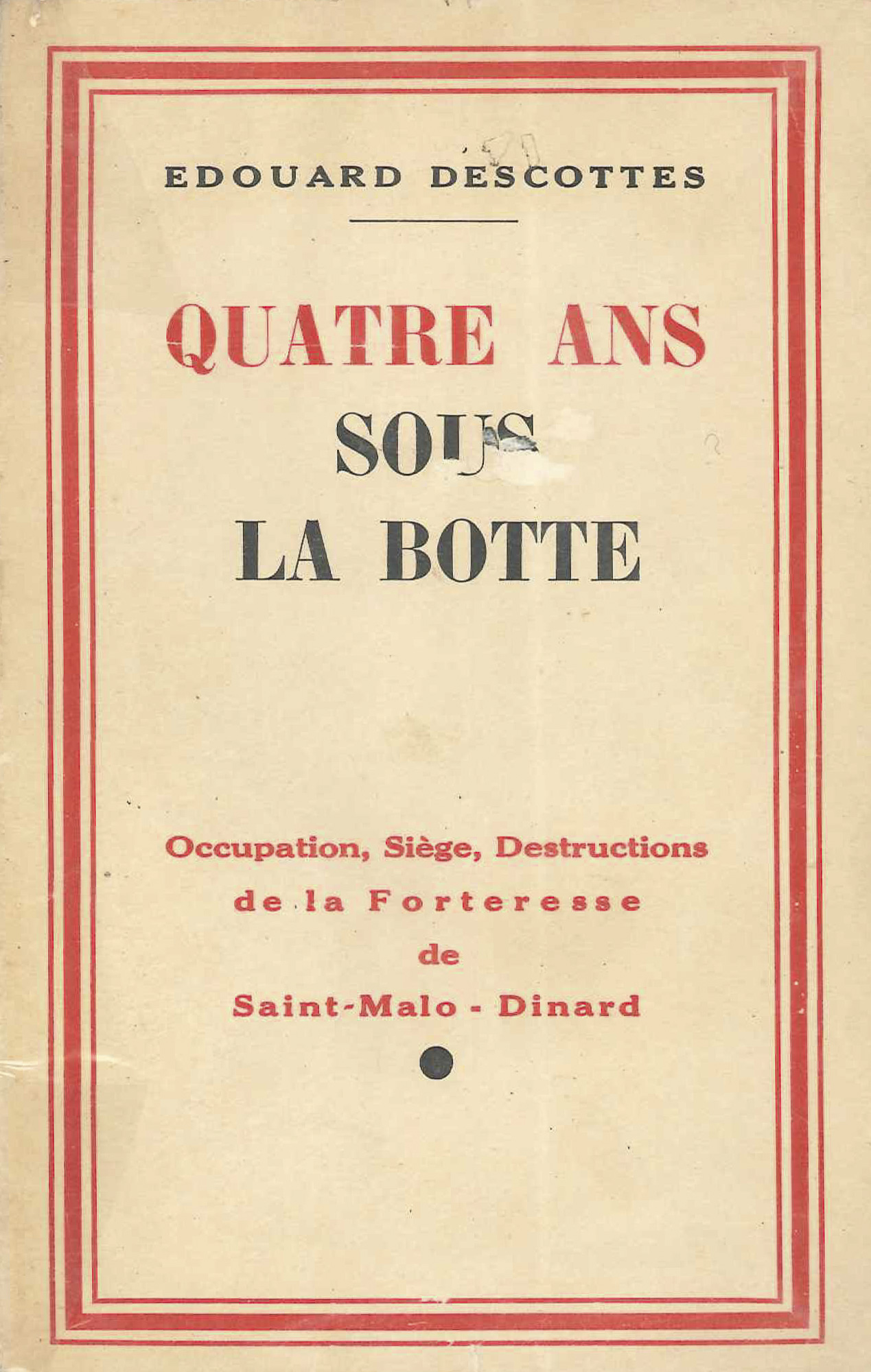Black jackboots or “marching boots” (Marschstiefel), already used by the German infantry during World War I, were still part of the German army uniform during World War II, though they were gradually replaced by lace-up ankle boots (Schnürschuhe) from 1941 onwards. Although the phrase “sous la botte” was already used to describe German domination during World War I, it became widely used in reference to World War II, sometimes associated in the titles of books from the Liberation collection (1944-46) with a more or less precise time-span, ranging from 1940 to 1943, 1944 or 1945. The expression has become synonymous with that period of German occupation of France and Belgium. The military boot has become strongly associated with the image of the German soldier/officer in popular imagination and cultural representations, from contemporary posters to current historical movies. According to Google search results, they seem to be a particularly successful retail item nowadays, whether as (presumed) original artefacts, or as faithful reproductions. The footwear was used as a potent symbol of the German occupation of France and Belgium and of the oppression endured by the local populations. In particular, the recurring use of the expression “sous la botte” provided an evocative image of the German occupation as an oppressive regime of (military) tyranny (eluding the responsibility of the Vichy government and the question of French collaboration).


As of today, 20 books in the Liberation collection mention the (German/Nazi) “botte” in their title and/or on their cover. A series entitled “4 ans sous la botte” was published in Lyon by Éditions Optic, though we only have one title in this collection (Journées d’angoisse: roman by Tania Kirchberger, 1944, Liberation.c.894). “Quatre ans sous la botte” is also the title of two items: a portfolio of satirical coloured illustrations created by Jean Dratz in 1945 (Liberation.a.237), and the book by Édouard Descottes, focusing on the “occupation, siège, destructions de la forteresse de Saint-Malo-Dinard” (1946?, Liberation.c.23).


“Sous la botte” is the title of a collection of poems by Barthélemy Ott published in 1944 (Liberation.c.52), and of a book by Jean Castéras illustrated by Bruno Max, Agen, 1946 (Liberation.c.299), while “Sous la botte nazie” is the name of the “drame patriotique en 4 actes” published by Paul Dellettre in 1945 (Liberation.c.320). The phrase “sous la botte” frequently refers to the German occupation of various French localities, such as En Ardenne sous la ‘botte’ by Francis Paulet, 1944? (Liberation.c.431), Lyon sous la botte, Lyon, 1944? (Liberation.a.160), Évron sous la botte by Daniel Bussinger, 1950? (Liberation.c.1246), or the set of 24 black and white photographs Orléans sous la botte, juin 1940-août 1944, 1945 (Liberation.c.358). As for the short history L’illustre théâtre sous la botte: 1940-1943, written by the company director Michel Richard, it was published in Lyon in 1945 (Liberation.c.1144), and special copies were set aside for Jacques Copeau (founder of the Parisian Théâtre du Vieux-Colombier) and Léon Chancerel (himself a pupil of Copeau and the teacher of Richard), as well as its comedians. Richard held both patriotic, anti-German and pro-Vichy opinions.


In the Liberation collection book titles, when it is qualified, the boot is either German (see Montluçon sous la botte allemande: 11 novembre 1942-24 août 1944 by Armand Gourbeix and Louis Micheau, Montluçon, 1945, Liberation.c.317 or Nos martyrs sous la botte allemande: où les ex-travailleurs juifs de Tunisie racontent leurs souffrances, edited by Gaston Guez, 1946? Liberation.c.2261) or Nazi (see the photographic album À Paris, sous la botte des nazis by Jean Éparvier, 1944, Liberation.a.33, and Sous la botte nazie: drame patriotique en 4 actes by Paul Dellettre, published in Belgium in 1945, Liberation.c.320).

Quite a few of the titles referring to the German boot are comic and satirical, illustrated books deriding both the French and their German oppressors. Some of them feature a cheeky young French hero, such as Biroulet sous la botte with drawings by Raymond Sempé, Bordeaux, 1944 (Liberation.a.37), which is a sequel to the three comic books entitled Les aventures de Biroulet he published from 1927 to 1929; or Gavroche sous la botte: les meilleures histoires drôles, 1940-1945, by M. Fougerole, illustrated by Joseph Hémard, 1945? (Liberation.c.304), named after the revolutionary character of Victor Hugo’s Les Misérables. In addition to Quatre ans sous la botte by Jean Dratz (Liberation.a.237), already cited, other humorous titles include Le rire sous la botte: bonnes histoires des mauvais jours by Georges Ravon & Jacques Patin, with black and white illustrations by Lucien Chauffard, Avignon, 1945? (Liberation.c.432); or Rires sous la botte by Lucien Besnard, Nancy, 1945 (Liberation.c.54).
After this survey of the use of “sous la botte” in the titles published in France and Belgium at the end of the Second World War, a second blogpost will focus on the striking depictions of the German boot on the front cover of books in the Liberation collection.
Irène Fabry-Tehranchi
More about WW2 German military boots and uniforms:
Angolia, John R.; Schlicht, Adolf (1984). Uniforms and Traditions of the German Army 1933-1945 (3 vols.). R. James bender Publishing.
Davis, Brian L. (1971). German Army Uniforms and Insignia 1939-1945. London: Arms and Armour Press. 9001.c.7078 ; 9420.c.4462 ; 9420.b.671
Ellis, Chris; Gordon-Douglas, S. R. (1973). German Combat dress, 1939-1945. London: Almark Publishing. Ud.6.1409

